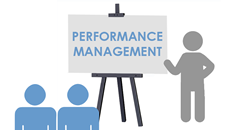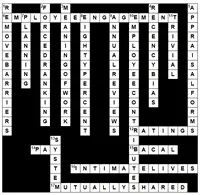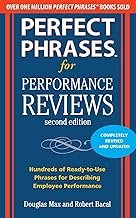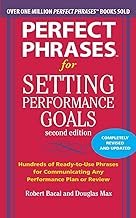How Performance Management and Appraisal SHOULD Work - A Case Study
(Ed. The following is from Performance Management 2/E (Briefcase Books Series) by Robert Bacal and can be purchased at local bookstores or on amazon.com by clicking on the link above.)
Now that we've covered the principles and process of performance management, what does it look like in action? Remember the story that opened Chapter 1, about Michael and the Acme Progressive Company? Michael wasn't managing performance with the fourteen staff members who reported to him. Whatever he did probably hurt more than helped. Well, something happened to Michael while you were reading this book.
He got a new boss. Marie was hired from outside Acme to help get the company on track. Tough, supportive, and talented, she decided things were all too chaotic and it was time to take action.
The First Step toward Improving Performance Management
At the end of June, Marie asked Michael to schedule a meeting with her to discuss the performance of his department. After some preliminary chitchat, Marie got to the point: "Michael, I've been looking at the performance of all the departments in my division and I'm really concerned. We're going backward, and we need to turn it around or Acme is going to be in big trouble. I need to know from you what you think the problem is with your group."
After some thought, Michael replied: "I know productivity seems to be down, but it's like we have more and more work and less and less time. My staff is getting worn down and they seem to be making a lot more mistakes. Frankly, we could do with more staff."
Marie shook her head slowly, and then explained that, because of Acme's financial situation, staffing levels had been frozen. Then she continued: "I know you're really busy, but ‘busy' isn't the point, is it? Everyone may be working hard, but is it possible that they may not be focusing on the really important things they need to do to get productivity up?"
"It's interesting you bring that up," Michael replied. "It looks to me like people are forgetting what's important and not so important. In fact, we seem to be spinning our wheels."
"Good," Marie said. "That's my impression also. How are you working with staff to keep them focused on the important work and making sure it gets done efficiently? How are you managing their performance?"
Michael paused for a moment, looking a bit embarrassed, and then answered: "Well, you know I'm pretty busy. But we have meetings every two months to talk about the work and we do that once-a-year thing that the personnel department forces us to do—you know, with those forms to fill out?"
"I know about those forms," Marie sighed. "They make me turn them in too."
She paused, and then continued: "That's not enough. We need to do something here to help you and your staff or there are going to be some serious shake-ups.
"Here's what we're going to do. I'd like you to start managing performance with your staff—and it's got to be meaningful. But it's not something you have to do on your own. I'll be doing the same things with all my managers. So, while I'm helping you with your performance, you'll be using the same techniques to help your staff.
"Here's how we're going to start. The vice presidents have set a number of goals and objectives for the company for the next year. Each department is expected to contribute to achieving those goals. In about a year you and I are going to sit down and assess whether your department has met that obligation. As the manager, I expect you to be accountable and responsible for making sure it happens."
Michael, looking a bit green, said: "Well, OK, I guess that's why I get paid the big bucks. How are you going to measure this? Not with that horrible ratings form, I hope?"
"No," Marie answered quickly. "You and I are going to talk and set objectives for you personally. That's what we'll measure. Those measures need to be simple and possible to measure. And we'll develop them together, but mostly you will be suggesting them, since you know your job best."
"And I guess you want me to do the same thing for my staff?"
"Exactly." Marie nodded energetically. "That's how we'll coordinate the company's goals with your department's goals and the objectives for your staff. We'll still have to complete those ratings forms, but I've talked to personnel and they've agreed, for now, to let you add some notes to them. Maybe next year we can convince them to drop the ratings entirely."
Michael felt ready to deal with specifics, so Marie closed the meeting by scheduling another.
"What I'd like you to do," she said, "is take the goals and objectives for the whole company and discuss them with your staff. You and I will get together again in about three weeks to set your department's goals and your personal objectives and standards, which we'll use to assess your progress at the end of the year. Then, you're going to do something similar with your staff, and you will measure and manage their performance the same way." She paused. "What do you think?"
"I'm not sure I have much choice," Michael admitted, "but I'll give it a try."
After a little more discussion, Marie gave Michael some material on performance management and writing objectives and standards. Then they scheduled their next meeting.
Michael reviewed the overall goals for the company, and then called a staff meeting. At that meeting, he explained that employees needed to link their individual performance to achieve the goals set for the organization. They all discussed what they would need to do and came up with a set of goals and objectives for the department.
Michael closed the meeting by explaining what was to happen next: "I'm taking our goals up to Marie to make sure she feels we're aiming at the right bull's-eye. They might change a bit, but I think we have them pretty well nailed down. After speaking with Marie, I want to schedule a meeting with each one of you to discuss how your work in the next year is going to tie into our overall goals. At that time, we'll decide how to keep track of progress and determine how we're going to evaluate your work against those objectives."
Agreeing on Goals and Objectives
About three weeks later, Marie and Michael met again. They went over the goals and objectives set for the department and finalized them so they aligned with those of the company.
Then Marie summed up the results. "OK, Michael, now these are the things we've agreed that you and your department are going to achieve. You need to increase your sales by 10%, which seems a realistic goal. We need to limit errors in the ordering system, with our starting goal being one error a month. Also, we want to cut by 50% justified customer complaints going to the customer service department."
She paused and looked at Michael. He nodded slowly in agreement. Marie moved on.
"One more thing we've agreed upon is that the only way we can achieve these goals is if you carry out your managerial responsibilities regarding performance management with your staff. Now, since these are the criteria we're going to use to evaluate your performance, we need to be sure about them. Are those goals clear to you? Do they make sense? Will they get us where we need to go?"
Michael was a bit concerned. "What happens to me when we do our appraisal and I fall short? I don't know if I can control all these things."
"Good question." Marie replied. "OK, here's how we'll work it. Once a month you and I will meet for about fifteen minutes to discuss progress toward these goals and objectives. If it happens that we aren't making progress, then we'll figure out how to overcome any obstacles. If necessary we'll include your staff. OK?"
Michael nodded.
"My job is to help you do your job," Marie said, "and your job is to help your staff do theirs. Frankly, I'm not concerned that you won't meet the objectives, because together we can do and will do it. But, to answer your question, I won't be concerned if we miss those targets by a bit, provided we continue to improve. If we don't improve at all, then we'll have to take action, depending on why we haven't. You and I will look at our successes and any failures at your year-end performance review meeting. Then, we'll figure out where to go from there."
At the end of the meeting, Marie and Michael listed the objectives and standards that would be used to evaluate Michael and his department. To record their agreement, they had the objectives and standards typed up on a single sheet of paper, and had two copies made. Each signed both copies and kept one.
Planning Performance with Staff
In August, Michael met with each employee as Marie had met with him, to establish what each employee should do to contribute to the department's success and to agree on the standards for reviewing each employee's performance. Rather than establish standards himself, Michael asked each person to set them.
For example, this is how he handled that matter with Sarah, the receptionist and switchboard operator:
"Since we're concerned about customer service, we should decide on what would be the maximum number of rings for any phone call. What would you recommend?"
"Well," Sarah answered slowly, "I don't know."
"Would fifty rings be reasonable?"
"No," she laughed. "That would be much too long."
"Well," Michael asked, "how about two rings?"
"No, that's impossible—not practical."
Michael and Sarah continued back and forth, until eventually they agreed on a target of five rings. They decided to allow some leeway, agreeing that 95% of phone calls should be answered within five rings and that no call should ever ring more than fifteen times, under any circumstances. They thought this reasonable maximum would greatly reduce complaints about poor phone service.
Before they moved on to the next objective and standard, Michael asked: "OK, now, here's the key question. What do you need to be able to meet that standard? What can I do to help?" Sarah suggested a few small changes regarding phone coverage during coffee breaks and lunch and recommended buying a low-cost cordless headset so she could answer the phone even if she were away from her desk.
At the end of the meeting, Michael and Sarah followed the simple documentation process, recording the tasks, objectives, and standards they'd agreed upon.
In August, Michael completed meetings with each staff member, clarified jobs and standards, and identified small, inexpensive changes they could make to help meet their objectives. In the process, he discovered a few things.
First, he realized that there were a lot of little obstacles and annoyances interfering with productivity—barriers they could remove or minimize themselves with no cash outlay. Second, he found that once staff understood that he was there to help them do their jobs, not to beat them, they were cooperative, even happy with the process. Several times, at the end of meetings, employees even asked why Acme had waited so long before starting performance management.
Communicating about Progress and Solving Problems
During the year, Michael met regularly with employees to review their progress. Each month, in ten-minute, one-on-one meetings, he and each employee addressed two questions:
• How are you progressing in meeting your goals?
• What problems are you encountering?
In some cases, Michael noted the difficulties encountered. Sometimes a staff member needed to upgrade his or her skills, so Michael provided training and coaching. As time went on, he found it necessary to change some of the objectives and standards, because the company altered its priorities. Sometimes responsibilities shifted around; some were added and some were eliminated. After each series of regular meetings with his staff, Michael met with Marie, to update his boss and discuss his responsibilities with her as each of his employees had done with him.
Preparing for the Yearly Review
March 31 marked the end of Acme Progressive's fiscal year. One of Michael's responsibilities was to do a year-end performance review with each of his staff members. Since Michael knew he was going to be evaluated on those reviews, he was well motivated. Here's how he handled the reviews.
At a general staff meeting in late February, Michael reminded all of his employees that it was time to schedule meetings to discuss the past year's performance and plan for performance for the next year.
"As you all know, we've been working on improving our overall performance and meeting regularly to do that. It looks to me as if we've succeeded in clearing out some barriers and meeting our departmental goals. What we need to do next is discuss problems you faced in meeting your individual objectives and decide where we need to go for the next year.
"Since I've been meeting regularly with you, I don't expect any surprises, for you or for me. You all know where you stand, so we just need to do some paperwork and plan. I'd like you to look at the performance planning notes we made in our individual meetings and any other notes you might have from our regular progress meetings.
"When I meet with each of you, I'm going to ask you whether you feel you've hit the targets we set together and, just as we have done in our progress meetings, we'll look to remove future barriers. We'll make some notes and each of us will sign them. Of course, we'll also complete that rating form required for personnel. But we'll focus on the goals we negotiated."
Reviewing and Evaluating
In March, Michael met with each employee. He tried to speak very little, be as helpful as possible, and encourage the employee to evaluate his or her progress. For the most part, it worked well. There were no surprises for anyone.
In one instance, however, there was a problem. Fred had consistently missed the targets he'd set with Michael. Because Fred and Michael had been meeting regularly, both were anticipating a problem. How did Michael handle this?
First, he and Fred established that there was indeed a performance gap. Michael used notes from the progress meetings to inform the discussion. He then started a diagnostic process to determine what had been causing the problem, as they'd done in their monthly meetings. They then agreed that Michael would continue to coach Fred.
Although Michael was generally supportive, he had to make sure Fred understood that both he and the company were serious about meeting performance goals.
Here's what he said:
"Fred, I'll continue to work with you. You've met some of your objectives and sometimes even surpassed what we asked of you. That tells me you have the ability to meet the rest of them in the new year. So, please come to me if you have any difficulties, and we'll continue to meet regularly. It might be, though, that you would be more successful in a job that builds on your strengths: that's something you and I need to look at if you miss your targets in the next quarter.
"So we don't lose sight of the issues, I've made some notes outlining our course of action. We'll both sign this paper, but I'm going to hold onto it for another three months. If you hit your interim targets for the next quarter and the next year, then I'll destroy the notes. If you miss your targets, the notes and documentation will go into your personnel file, and we'll need to figure out what to do next."
Fred reluctantly agreed.
The Outcomes
How does the story end? In fact, it never ends. The performance management process begins anew: the appraisals not only end the year but also begin the planning process for the next year. Let's summarize the outcomes.
Michael and his boss, Marie, met to do his appraisal. The results were good, although not news. Michael's department and Michael had met or surpassed all the goals. Marie and Michael were so pleased with the positive results that they met with the vice president of human resources to discuss their success and ask that everyone at Acme be given more flexibility. Personnel finally got rid of the required ratings forms.
Clearly the policy of "no surprises" worked well. Michael and his staff identified barriers early on and overcame most of them. Employees knew where they stood during the year and Michael had the information he needed. On a corporate level, everyone benefited by the linking of individual and departmental objectives to the overall goals of the company.
What about Fred? In a perfect world, Fred would have met his next year's objectives. Unfortunately, Fred continued to struggle, despite everyone's efforts to help. Eventually Michael decided to meet with Fred and the personnel department to see if another job at Acme would be more suitable. That way, the company could salvage its investment in Fred (the cost of hiring, training, etc.). Fred then chose to move (with great relief) to another position, where he could succeed. Could Acme have let Fred go? Yes, the firm had sufficient documentation to support that option—as a last resort.




